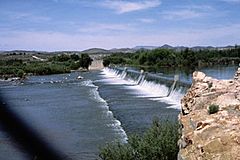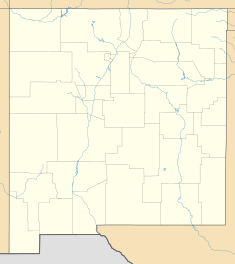Leasburg Diversion Dam facts for kids
Quick facts for kids Leasburg Diversion Dam |
|
|---|---|
 |
|
|
Location of Leasburg Diversion Dam in New Mexico
|
|
| Country | United States |
| Location | Doña Ana County, New Mexico |
| Coordinates | 32°29′50″N 106°55′22″W / 32.497231°N 106.922733°W |
| Purpose | Irrigation |
| Opening date | 1907 |
| Owner(s) | United States Bureau of Reclamation |
| Dam and spillways | |
| Type of dam | Diversion dam |
| Height | 10 feet (3.0 m) |
| Length | 600 feet (180 m) |
The Leasburg Diversion Dam is a special structure built on the Rio Grande river in New Mexico, United States. It was finished in 1907. Its main job is to take water from the Rio Grande and send it into a long canal called the Leasburg Canal. This canal is about 13.7 miles (22.0 km) (22 km) long. It carries water to farms in the upper Mesilla Valley, which is just north of Las Cruces, New Mexico. This helps farmers grow their crops by providing them with the water they need.
Contents
What is a Diversion Dam?
A diversion dam is different from a regular dam that creates a big lake. Instead of holding back a lot of water, a diversion dam's main purpose is to redirect water from a river into a canal or ditch. Think of it like a giant funnel that guides water to where it's needed most. The Leasburg Diversion Dam helps move water from the Rio Grande to farms for irrigation.
Where is the Dam Located?
The Leasburg Diversion Dam is located near a town that used to be called Leasburg. This town is now known as Radium Springs, New Mexico. It grew up around an old military post called Fort Selden, which is about 18 miles (29 km) north of Las Cruces. The dam is an important part of the water system in this area.
Building the Dam
Before the current concrete dam, there was an older, simpler dam. It was made from poles, twigs, and stones. This old dam also helped to move water for farming.
In 1905, a big plan called the Rio Grande Project was approved. This project aimed to manage the water of the Rio Grande better. As part of this plan, the U.S. Reclamation Service (now the United States Bureau of Reclamation) designed a new, stronger dam. They planned a concrete dam that would be 10 feet (3.0 m) (3 meters) high and 600 feet (180 m) (183 meters) long.
Work on the new Leasburg Diversion Dam began in November 1906. It was the very first dam finished for the entire Rio Grande Project.
How the Dam Helps Farmers
By 1908, the Leasburg Diversion Dam was fully working. It was sending water from the Rio Grande into the Leasburg Canal. This water helped irrigate a huge area of land – about 31,600 acres (12,800 ha) (12,788 hectares) – in the upper Mesilla Valley.
A few miles south of the dam, there was another important structure called the Picacho Flume. A flume is like a bridge that carries water. This steel structure was 502 feet (153 m) (153 meters) long and carried the canal water right over the Rio Grande river itself!
In 1919, the top of the Leasburg Dam was made a little taller, by about 1.25 feet (0.38 m) (0.38 meters). This small change likely helped to manage the water flow even better. The dam continues to play a vital role in providing water for agriculture in the region.


